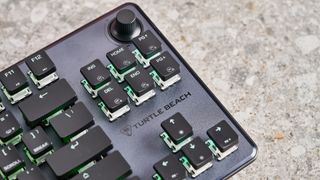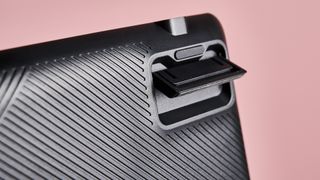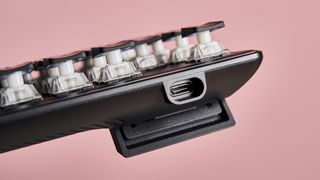Turtle
Beach
Vulcan
2
TKL
Pro:
one-minute
review
It’s
not
often
you
see
an
analog
keyboard
come
to
market,
but
Turtle
Beach
is
offering
a
new
one
in
the
form
of
its
Vulcan
2
TKL
Pro.
It
promises
ultra-smooth
and
fast
operation,
aided
by
the
in-depth
actuation
settings
in
its
accompanying
software,
Swarm
2.
Since
the
Vulcan
2
TKL
Pro
doesn’t
have
a
top
cover,
the
bare
keycaps
and
switches
are
immediately
apparent.
This
design
choice
is
both
aesthetically
pleasing
and
convenient,
as
it
makes
cleaning
and
swapping
out
the
keycaps
easier.
The
overall
form
is
compact
and
slender,
yet
the
materials
and
construction
feel
premium.
Swarm
2
doesn’t
put
its
best
foot
forward,
with
a
jagged
interface
and
a
severe
lack
of
explanations
for
the
numerous
settings
available.
Navigating
it
can
also
be
a
chore,
and
I
was
frequently
met
with
dialog
boxes
telling
me
I
had
to
go
somewhere
else
or
activate
a
certain
parameter
to
achieve
what
I
wanted.
It
also
crashed
on
one
occasion
during
my
time
using
it.
Beneath
it
all,
though,
there
are
some
great
customization
options
on
offer,
with
a
broad
selection
of
hotkey
functions
–
some
quite
advanced
–
and
the
actuation
adjustments
allow
for
a
great
deal
of
tinkering.
Again,
though,
it
can
be
hard
to
work
out
exactly
what
your
tweaks
are
accomplishing,
thanks
to
the
lack
of
visual
indicators
and
an
impractical
testing
procedure.

(Image
credit:
Future)
In
action,
the
Vulcan
2
TKL
Pro
performs
competently,
with
the
same
satisfying
keystrokes
and
comfortable
feel
as
any
of
the
best
gaming
keyboards,
and
the
mixture
of
convex
and
concave
keycaps
pays
dividends.
However,
typing
isn’t
the
easiest,
as
the
keys
are
quite
narrow,
and
gliding
around
them
isn’t
as
seamless
as
I’m
used
to.
The
analog
functionality
is
a
mixed
bag
for
gaming.
There
are
plenty
of
adjustments
in
the
actuation
point,
which
let
you
dial
in
your
preferred
pressure.
Rapid
Trigger
mode
is
also
useful,
allowing
for
fast
yet
controlled
inputs,
ideal
for
twitchy
character
movements.
However,
the
multi-point
actuation
seems
more
like
a
gimmick
than
a
useful
tool,
and
Controller
mode
falls
short
of
its
emulation
promises
since
the
keys
can’t
match
the
precision
of
analog
sticks
and
triggers.
In
practice,
I
doubt
gamers
will
use
it.
All
this
isn’t
to
say
the
Vulcan
2
TKL
Pro
isn’t
a
competent
gaming
performer.
It’s
satisfying
and
solid
to
use,
and
its
compact
design
makes
it
suitable
for
virtually
any
setup.
If
you
want
a
premium
gaming
keyboard
with
similar
analog
switches,
the
Razer
Huntsman
line
includes
models
with
them.
If
you
can
do
without,
there
are
plenty
of
keyboards
out
there
that
offer
similar,
if
not
better,
performance
than
the
Vulcan
2
TKL
Pro
for
the
same
price
or
less,
such
as
the
Asus
Rog
Strix
Scope
II
RX
and
the
Roccat
Magma.

(Image
credit:
Future)
Turtle
Beach
Vulcan
2
TKL
Pro
review:
price
and
availability
-
$149
(about
£113
/
AU$219) -
Black
and
White
colorways -
Wired
only
The
Vulcan
2
TKL
Pro
is
priced
at
$149
(about
£113
/
AU$219)
and
is
available
in
two
colorways:
Black
and
White.
It
also
comes
with
a
wrist
rest.
UK
and
Australian
markets
are
yet
to
receive
it.
For
a
tenkeyless
board
with
analog
switches,
the
Vulcan
2
TKL
Pro
is
good
value.
Similar
analog
offerings
from
the
likes
of
Razer
and
Corsair
can
set
you
back
over
$200.
If
you’re
not
bothered
about
analog
switches,
your
options
open
up
considerably,
but
even
when
considered
within
the
broader
gaming
keyboard
market,
the
Vulcan
2
TKL
Pro
is
still
competitively
priced.
However,
there
are
alternatives
that
undercut
the
Vulcan
2
TKL
Pro:
the
Asus
Rog
Strix
Scope
II
RX,
for
instance,
is
slightly
cheaper,
full-size,
and
has
mechanical
switches.
There’s
also
the
Roccat
Magma,
our
current
pick
as
the
best
gaming
keyboard
for
those
on
a
budget.
Value:
4
/
5
Turtle
Beach
Vulcan
2
TKL
Pro
review:
specs
to
scroll
horizontally
| Layout: | TKL |
| Switch: |
Analog (Hall-effect magnetic) |
|
Programmable keys: | Yes |
| Dimensions: |
14.5 x 5.5 x 1.5 inches (approx.) |
|
RGB or backlighting: |
Yes (customizable) |

(Image
credit:
Future)
Turtle
Beach
Vulcan
2
TKL
Pro
review:
design
and
features
-
Light
but
sturdy -
Satisfying
floating
keys -
Software
is
so-so
The
Vulcan
2
TKL
Pro
has
a
sleek,
lightweight
body,
made
from
anodized
aluminum
with
a
plastic
underside,
resulting
in
a
keyboard
that
feels
hard-wearing.
The
keycaps’
floating
design
helps
to
minimize
its
real
estate
even
further.
I
found
the
chassis
thin
enough
to
use
the
board
comfortably
without
needing
the
included
wrist
rest.
The
folding
feet
didn’t
provide
as
steep
an
angle
as
I
would’ve
liked,
but
it
was
still
within
the
bounds
of
acceptability.
Some
might
not
like
this
exposed
design,
but
I’m
quite
partial
to
it.
If
nothing
else,
it
makes
the
Vulcan
2
TKL
Pro
easier
to
clean,
as
dust
and
other
debris
have
no
place
to
hide
(I
dread
to
think
how
many
crumbs
are
lurking
beneath
the
crevices
of
my
other
keyboards).
It
also
makes
removing
the
keycaps
easier
when
you
want
to
swap
them
out
for
third-party
ones.
Despite
their
floating
nature,
the
keycaps
feel
secure,
firmly
fixed
in
place
with
little
play
or
wobble.
They’re
indented,
save
for
those
on
the
bottom
row,
which
are
convex
instead
–
a
smart
design
choice
that
makes
them
easier
to
press
with
your
little
finger
and
thumb.
There’s
also
a
handy
volume
dial
in
the
top-right
corner,
which
has
smooth
notches
and
a
solid
button
press
for
muting.
However,
neither
the
dial
or
the
button
can
be
remapped
to
perform
other
functions.
To
get
the
most
out
of
the
analog
switches
in
the
Vulcan
2
TKL
Pro,
you’ll
need
to
acquaint
yourself
with
Swarm
2,
Turtle
Beach’s
peripheral
software.
Unfortunately,
it
fails
to
make
a
great
first
impression.
The
typeface
is
rendered
poorly
and
the
layout
isn’t
exactly
intuitive.
I
frequently
encountered
dialog
boxes
telling
me
certain
functions
and
features
weren’t
available
without
navigating
to
another
tab,
and
many
settings
just
aren’t
explained
well
–
or
even
at
all.
There’s
also
no
way
to
see
a
quick
overview
of
the
rebind
choices
you’ve
made
–
you
have
to
click
on
each
individual
key
to
reveal
them.

(Image
credit:
Future)
I
experienced
one
crash
during
my
time
with
Swarm
2;
a
settings
adjustment
window
failed
to
open
and
the
app
froze
before
shutting
down
altogether.
A
simple
restart
fixed
the
issue,
though.
It
contains
many
of
the
standard
features
you’d
expect
from
peripheral
software,
including
RGB
adjustments,
multiple
profile
slots
(five),
and
a
macro
creator.
It
also
offers
different
layers
for
customization,
including
a
Game
Mode
(not
to
be
confused
with
Windows’
own
Game
Mode),
which
is
activated
by
pressing
FN+Start
(again:
not
made
clear),
and
an
Easy
Shift
mode
that
can
be
activated
by
holding
caps
lock.
You
can
set
it
to
toggle
instead,
but
this
option
isn’t
easy
to
find,
buried
in
the
hotkey
rebind
section.
Speaking
of
which,
there
are
plenty
of
hotkey
options
in
Swarm
2.
The
selection
is
both
broad
and
useful,
including
some
pretty
advanced
functions
that
can
be
activated
with
a
single
keypress,
such
as
opening
a
Direct
X
diagnostics
tool
and
the
Windows
Registry
Editor.
The
real
meat
of
Swarm
2,
though,
lies
in
the
detailed
actuation
adjustments
available.
The
Vulcan
2
TKL
Pro
has
Hall-effect
magnetic
switches,
with
the
actuation
point
of
each
adjustable
from
0.1-4mm.
You
can
also
increase
or
decrease
actuation
via
two
hotkeys
on
the
plus
and
minus
keys.
The
number
key
LEDs
light
up
to
indicate
your
adjustments,
but
they
aren’t
clear
enough
to
tell
what
setting
you’re
on.
There
are
also
Rapid
Trigger
and
Multi-input
modes.
The
former
lets
you
adjust
the
point
at
which
the
key
resets
to
accept
further
inputs,
independently
from
the
actuation
point.
This
allows
for
quick,
controlled
movements
and
key
spamming.
You
can
select
individual
keys
to
apply
Rapid
Trigger
to,
but
Swarm
2
fails
to
mention
that
you
can
click
and
drag
to
select
multiple
keys
instead.
More
obscurities
can
be
found
in
the
test
mode
for
Rapid
Trigger,
as
it
fails
to
provide
visual
feedback
for
the
adjustments
you
make,
which
would
be
extremely
useful
in
helping
you
see
the
direct
effect
of
your
tweaks.
Multi-input
mode
lets
you
create
up
to
three
different
inputs
for
the
same
key,
depending
on
how
hard
you
press.
With
this
setting,
you
can’t
assign
controller
inputs,
only
keystrokes
and
mouse
clicks
are
permitted.
One
of
the
problems
with
both
these
modes
is
that
you
can’t
adjust
and
test
your
settings
in
the
same
window,
which
would
streamline
the
whole
process.
You
can,
however,
do
this
in
Controller
mode.
This
mode
allows
you
to
assign
keys
to
gamepad
inputs.
To
achieve
this
in-game,
the
Vulcan
2
TKL
Pro
emulates
a
controller
(I
suspect
it
utilizes
XInput,
Microsoft’s
protocol
for
using
gamepads
on
PC).
This
includes
the
emulation
of
analog
sticks
and
trigger
buttons,
letting
you
modulate
the
amount
of
input
based
on
how
far
down
you
press
the
keys.
In
theory,
this
is
useful
for
games
requiring
careful
movement
–
there’s
even
a
handy
WASD-to-analog-stick
quick-bind
setting
for
this
very
purpose
–
and
vehicle
control.
There’s
also
an
angle-snapping
option
in
this
mode,
offering
0-90
degrees
of
‘snapping’;
useful
if
you
want
to
adjust
the
separation
between
the
x
and
y
axis.
Design
&
features:
3.5
/
5
Turtle
Beach
Vulcan
2
TKL
Pro
review:
performance
-
Good
for
gaming -
Adjustable
actuation
points -
Controller
mode
impractical
Thanks
to
those
floating
keys,
the
Vulcan
2
TKL
Pro
has
a
typewriter-like
feel,
which
creates
a
greater
sense
of
feedback.
Despite
this,
it
isn’t
a
board
I
would
recommend
for
frequent
typing.
The
T-shaped
ABS
keycaps
are
narrower
than
those
on
most
gaming
keyboards,
and
I
found
they
took
some
getting
used
to.
Gliding
over
them
isn’t
seamless,
due
to
the
steep
indentations
on
the
keycaps,
while
the
small
enter
key
is
hard
to
locate
by
feel.
Having
the
ability
to
adjust
the
actuation
point
across
a
wide
range
certainly
helps
to
prevent
mispresses,
but
if
you’re
thinking
of
using
your
board
for
productivity
as
well
as
gaming,
this
likely
won’t
be
for
you.
If
you’re
only
concerned
with
the
latter,
the
Vulcan
2
TKL
Pro
acquits
itself
well.
The
switches
are
very
clicky,
with
enough
damping
to
feel
pleasant
to
use,
but
if
you
really
hammer
down
on
them
you’ll
be
met
with
a
harsh
thud.
The
aforementioned
actuation
adjustments
make
for
quick
responses,
and
those
indented
keycaps
help
secure
your
fingers
in
place.
The
standard
Actuation
Point
and
Rapid
Trigger
modes
generally
live
up
to
their
promises.
The
former’s
adjustment
options
result
in
meaningful
changes
to
keystroke
sensitivity,
while
the
latter’s
allow
you
to
perform
quick-twitch
movements
with
greater
speed
and
accuracy
once
set
to
your
preferences.

(Image
credit:
Future)
However,
the
same
can’t
be
said
for
Multi-input
mode,
as
applying
the
exact
amount
of
pressure
to
hit
a
certain
actuation
point
for
a
certain
input
is
difficult.
I
struggle
to
think
of
many
gaming
situations
where
this
functionality
would
be
useful.
You
also
can’t
assign
controller
functions
in
this
mode,
which
seems
like
a
missed
opportunity;
only
keystrokes
and
mouse
clicks
are
assignable.
And
then
there’s
Controller
mode.
In
theory,
this
is
a
nice
idea,
but,
in
practice,
it
fails
to
translate
analog
inputs
from
gamepads
to
keystrokes
as
smoothly
as
I
would’ve
liked.
Changing
the
response
curve
to
the
precision
setting
did
help
to
make
movements
somewhat
more
controlled,
but
still
not
enough.
Maneuvering
in-game
vehicles
was
too
jerky
during
my
tests;
the
greater
weight,
size,
and
resistance
of
analog
sticks
and
trigger
buttons
are
much
better
suited
to
the
task.
There’s
also
the
issue
of
which
games
practically
support
Controller
mode.
In
Grand
Theft
Auto
5,
for
instance,
I
found
a
clash
between
gamepad
and
keyboard
control
schemes.
Naturally,
moving
a
character
forward
and
backward
with
a
controller
requires
moving
the
analog
stick.
However,
in
vehicles,
accelerate
and
brake/reverse
are
bound
to
R2
and
L2,
with
no
option
in-game
to
alter
this.
This
means
that
binding
WASD
to
analog
stick
controls
will
let
you
move
a
character
in
all
directions,
but
with
vehicles,
you’ll
only
be
able
to
steer
left
and
right.
You
could
keep
W
and
A
bound
as
they
are
and
sacrifice
some
of
that
nuanced
control,
or
use
the
easy
shift
function
on
the
Vulcan
2
TKL
Pro
as
a
workaround,
but
this
will
require
you
to
press
caps
lock
every
time
you
switch
between
pedestrian
and
vehicular
travel.
In
other
words,
it’s
simply
too
impractical
to
be
worth
using.
Performance:
3.5
/
5
Should
I
buy
the
Turtle
Beach
Vulcan
2
TKL
Pro?
to
scroll
horizontally
| Attributes | Notes | Rating |
|---|---|---|
| Value |
For an analog keyboard, the Vulcan 2 TKL Pro is priced well and even undercuts those with other switches. It still isn’t what you’d call budget, though. |
4 / 5 |
|
Design and features |
The size and build are great, and the software has plenty of options, but it’s not the easiest to use and some features aren’t useful. |
3.5 / 5 |
| Performance |
Keystrokes feel satisfying and the analog response is smooth in certain scenarios, but impractical in others. |
3.5 / 5 |
Buy
it
if…
Don’t
buy
it
if…
Also
consider
to
scroll
horizontally
|
Header Cell – Column 0 |
Turtle Beach Vulcan 2 TKL Pro |
Razer Huntsman V3 Pro Tenkeyless |
Razer Huntsman V2 Analog |
|---|---|---|---|
| Layout: | TKL | TKL | TKL |
| Switch: |
Analog (Hall-effect magnetic) |
Razer Analog Optical Switch Gen-2 |
Razer Analog Optical Switches |
|
Programmable keys: | Yes | Yes | Yes |
| Dimensions: |
14.5 x 5.5 x 1.5 inches (approx.) |
Not stated |
Not stated |
|
RGB or backlighting: |
Yes (customizable) |
Yes (customizable) |
Yes (customizable) |
How
I
tested
the
Turtle
Beach
Vulcan
2
TKL
Pro
-
Tested
for
two
weeks -
Played
multiple
genres -
10+
years
PC
gaming
experience
I
tested
the
Vulcan
2
TKL
Pro
for
around
two
weeks,
during
which
time
I
used
it
for
gaming,
productivity,
and
general
use.
I
played
Counter-Strike
2,
the
acid
test
for
peripherals,
as
well
as
games
involving
vehicle
control,
such
as
Art
of
Rally
and
Grand
Theft
Auto
5.
I
have
been
PC
gaming
for
over
10
years
–
and
many
more
than
that
on
numerous
other
platforms
–
and
during
that
time,
I
have
used
many
different
types
of
keyboards
from
a
wide
range
of
brands.
-
First
reviewed
September
2024
